Brief Summary
Outdrives are not without their problems. For one thing, with just one look you can see that the power generated by the engine has to take a fairly tortuous route before it gets to the propeller(s). Add to that the fact that outdrives operate in water, and in a lot of cases, saltwater, and you can see that there is a potential for trouble. Some of the worst culprits are corrosion, water intrusion, bellows degradation and maintaining the drive oil. But there’s good news. The engineers at Volvo Penta have developed the OceanX which solves or controls most of these problems. It does that by dealing with lower unit challenges before they become problems. And as far as corrosion goes, its newest alloy and coatings have slowed it to a snail’s pace. Let’s take a closer look at the components and features that make this lower unit the state-of-art outdrive on the market.
Key Features
- Designed for select Volvo Penta gasoline and diesel engines
- New corrosion resistance technology with titanium-ceramic surface
- Sterndrive oil sensor warns the boater when drive oil is low or contaminated with water
- Fresh water cooling
- Water-intrusion sensor in the universal joint bellows
- The Drive sensor monitors the quality and level of the drive’s critical gear lubricant
- The U Joint Bellows sensor alerts if water intrudes in the bellows area
- Sensors not functional with D3 engine applications
Specifications
| Type of Engine | |
|---|---|
| Number of Cylinders | |
| Horse Power | 800 |
| Configuration | |
| Weight | |
| Fuel Type | Both (Gasoline or Diesel) |
| Fuel Delivery | |
| Shaft Length Options | |
| Shift Throttle Control | |
| Displacement | |
| Steering Control | |
| Recommended Fuel | |
| Alternator Output | |
| CARB Rating | |
| Engine Monitoring System |
Captain's Report
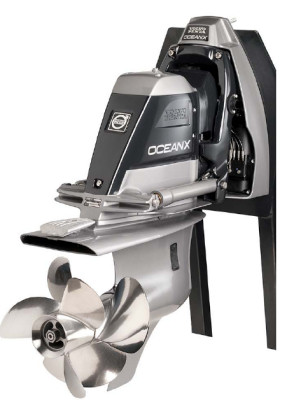 Not only is the new OceanX outdrive attractively designed, but it’s engineered for the long haul. Not only is the new OceanX outdrive attractively designed, but it’s engineered for the long haul.
First the Basics |
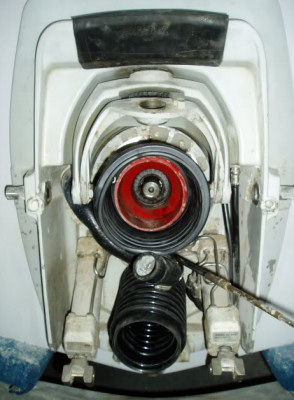 The rubber bellows are an Achilles heel in any stern drive lower unit. The rubber bellows are an Achilles heel in any stern drive lower unit.
For starters, the most plaguing problem is with the bellows system. Where the outdrive connects to the transom of your boat, there are rubber bellows, much like an accordion, that keep water out of the universal joint gimbals, while still allowing the drive unit itself to pivot back and forth as it steers your boat. So what’s the problem? |
The Volvo Penta Solution
Wouldn’t it be nice if the drive itself let us know if we had a problem? That’s what the team at Volvo Penta asked and… go figure, they answered “yes, it would!” The OceanX solution is to add a sensor to the gimbals to detect if there is any water intrusion through the bellows and alert you before you start to have parts fail. Gone are the premature haul outs to “check if maybe you have a problem” and gone are the rusted gimbals failing at the worst possible time.
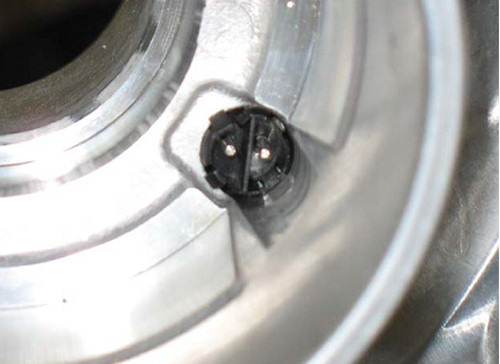 It may not look like much, but this little gem is the water intrusion sensor mounted to the gimbal inside the bellows. Its job is to save you money.
It may not look like much, but this little gem is the water intrusion sensor mounted to the gimbal inside the bellows. Its job is to save you money.
Problem #2
Now to be sure, the gearing inside an outdrive takes a fairly tortuous route as the power makes its way from the engine to the propellers, with no less than two 90-degree turns and lots of room for failure along the way. This sensitive area is largely immersed in water, so again we have a potential water intrusion problem. Thus it’s important that these parts all get their fair share of lubrication. That’s where the drive oil comes in. Contaminated oil will quickly lose its viscosity (thickness) and fail to continue lubricating these critical components. In addition, the water (particularly saltwater) will quickly corrode and wear away the gearing.
The OceanX Solution
Again, sensors are the key. Volvo Penta has fitted the drive gear case with a sensor that not only detects when water contaminates the oil, but it also alerts the operator to a low oil condition. We’ve seen this work in practice in our tests of the drive system and it’s inarguably a huge leap forward. Both the bellows sensor and the drive oil sensor are firsts in the industry… not a surprising claim to fame for Volvo Penta (which invented the stern drive in 1957).
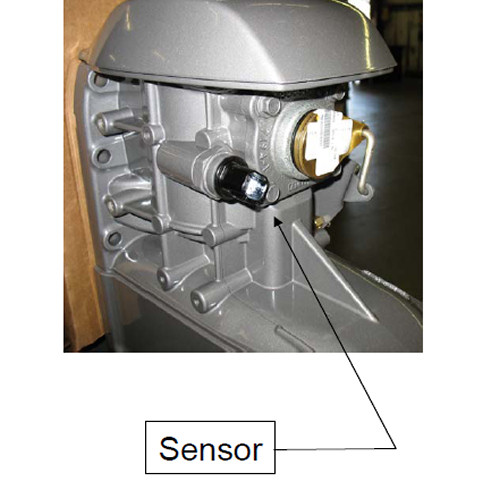 Here is a view of the drive oil sensor mounted in the gear case. It alerts the skipper to a low oil level as well as water contamination.
Here is a view of the drive oil sensor mounted in the gear case. It alerts the skipper to a low oil level as well as water contamination.
Problem #3
We still have the problem of metal components in a harsh saltwater environment. That means corrosion. Anyone who has ever spent time on the water, or even around a dock, will recognize the familiar images of a corroded outdrive. It isn’t pretty or cheap. Not only is the harsh salt water a critical offender to metal, but galvanic corrosion-- metal deterioration from electrical currents -- is just as damaging.
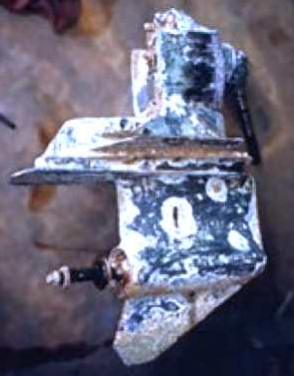 And then there is the matter of corrosion.
And then there is the matter of corrosion.
The OceanX Solution
Here, Volvo Penta went on a full frontal attack. They start with an electro-deposition treatment. This is based on the fundamental physics principle that opposites attract. The metal parts are charged with direct current and then immersed in a bath that has oppositely charged particles in it. This allows every corner, crack, and crevice to have a continuous even coating over the entire surface of the part. But the real kicker is the coating itself. Volvo Penta uses a titanium-ceramic coating for exceptional corrosion protection. It’s flexible, so less prone to flaking and chipping off.
Now all that is well and good while in the showroom or on a new boat. But the question on our minds is -- what happens when it gets scratched? Now you’ve removed the coating and exposed the bare metal, right? Wrong. Volvo actually tested this in four parts of the globe by immersing intentionally damaged drives into warm salt water and tested the differences. The results were outstanding, they tell us. The outcome of the tests shows a 400 – 500% improvement with the new treatment, resulting in less corrosion creep from the scratched surface according to Volvo engineers.
Now there are also sacrificial anodes -- zincs -- that come into play. You have them in your engine, and they’re also attached to the drives. Their job is to deteriorate before other metal components do. They sacrifice themselves for the greater good. We looked at the test above and asked what would happen if the zincs were eaten away and you didn’t notice? Now you have a significant reduction in protection, right? Again, we were wrong.
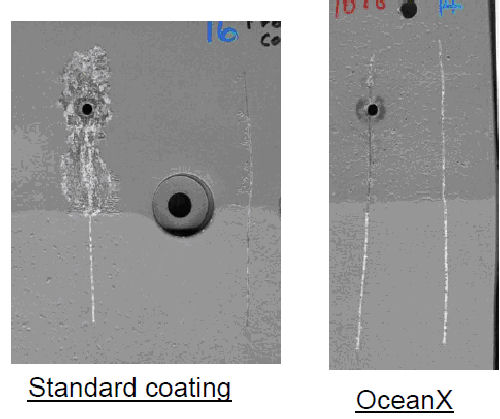 Here you can see visible differences in a scratched surface that was subjected to corrosive salt water over time in photos supplied to us by Volvo Penta. On the left, corrosion is able to creep into the scratched surface and expand the damaged area. On the right, the corrosion is kept to a minimum and barely affects the scratched surface at all.
Here you can see visible differences in a scratched surface that was subjected to corrosive salt water over time in photos supplied to us by Volvo Penta. On the left, corrosion is able to creep into the scratched surface and expand the damaged area. On the right, the corrosion is kept to a minimum and barely affects the scratched surface at all.
The folks at Volvo Penta tell us that the improved metal components in the OceanX outdrive will offer substantial corrosion protection beyond the competition. They back that statement up with their in-house testing and have provided us with photos of the results.
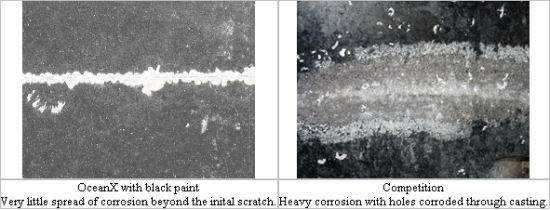 These photos were supplied by Volvo Penta.
These photos were supplied by Volvo Penta.
Volvo Penta is so confident in their new OceanX product that it is backing the OceanX with a four-year limited warranty against corrosion! We like companies that put their money where their mouth is.
Other Notable Facts About the OceanX
Here are some other tidbits we discovered during our tests--
- The OceanX drive weight is 200 lbs. (90.9 kgs.), and it has a trim/ tilt range from -5 degrees to +52 degrees.
- Prop sizes range from F2 to F9, which have average pitches of 18.5" to 29.5".
- Gear ratios for the OceanX are 1.78, 1.95 and 2.14. The 8.1L engine only uses the 1.78, the small block V8s can use any of the ratios -- it's boat speed dependent. The Formula 310 BR with a pair of Volvo Penta 5.7 Gi’s that we tested the OceanX outdrives on had the 1.78 ratio.
- The unit has maintenance-free gimbal bearing and u-joints.
- All exhaust is passed through the drive lower unit into the water. Volvo Penta doesn't allow exhaust to escape from the exhaust bellows. (Look for this feature in competing outdrives when you comparison shop).
- Power steering is standard!
- The trim pump is integrated and sealed in the transom shield. This dramatically eliminates corrosion problems for the trim pump.
- There are two anodes on the drive and shield, and the drive anode can be replaced while the boat is in the water.
- Propellers are installed with rubber bushings to reduce vibrations and protect drive components.
- There are no water inlets on the front face of the drive. This is a great feature for those who like to beach their boats or run in very shallow water. You won't have issues with sucking in sand and debris. (This is another rare feature to look for in competing brands).
- Integrated pitot tube in the lower unit for your speedo. You won’t have to drill into your hull to attach a speed sensing device.
- No shift cable bellows. We’ve seen a history of these parts failing and it can easily sink boats from time to time.
Recommendation
It’s easy to look at the OceanX and say, “oh, just another outdrive” but the reality is that this drive is a giant leap forward in both technology and corrosion protection. It’s backed by a great warranty and features some industry firsts. The competition was actually the first one out with a new anti-corrosion system several years ago, so Volvo Penta had the advantage of seeing what the competition did, then improve on that. And they did.
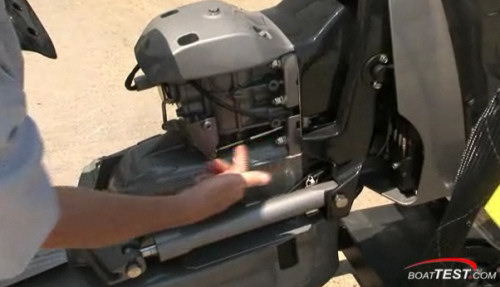 The shifting mechanism in the new OceanX is easily accessible and does not need bellows.
The shifting mechanism in the new OceanX is easily accessible and does not need bellows.
Of course, the new coatings, sensors, engineering and tooling all come at a price. The OceanX will cost you more than the standard lower unit. Check with your builder to find out exactly how much.
Is the OceanX lower unit worth the money?
To our way of thinking, that all depends if you go boating in saltwater or fresh, how much you use your boat each year, how well you maintain it, and whether you leave it in the water or dry sail it absolutely every time you use it. If you use your boat in saltwater then the answer is probably yes, it is well worth the money. If you only use your boat in fresh water a few weeks a year and take meticulous care of it, and plan to trade up in two or three years and haul it out after every use, then you probably don't need the added protection and safety features the OceanX provides.
But no matter where you do your boating and no matter how well you take care of your boat, when it comes to resale time, your boat should be worth more -- or should sell faster -- if you have the OceanX lower unit. It is definitely the preferred way to go, and on the used boat market it will give your boat a big leg up on the competition.